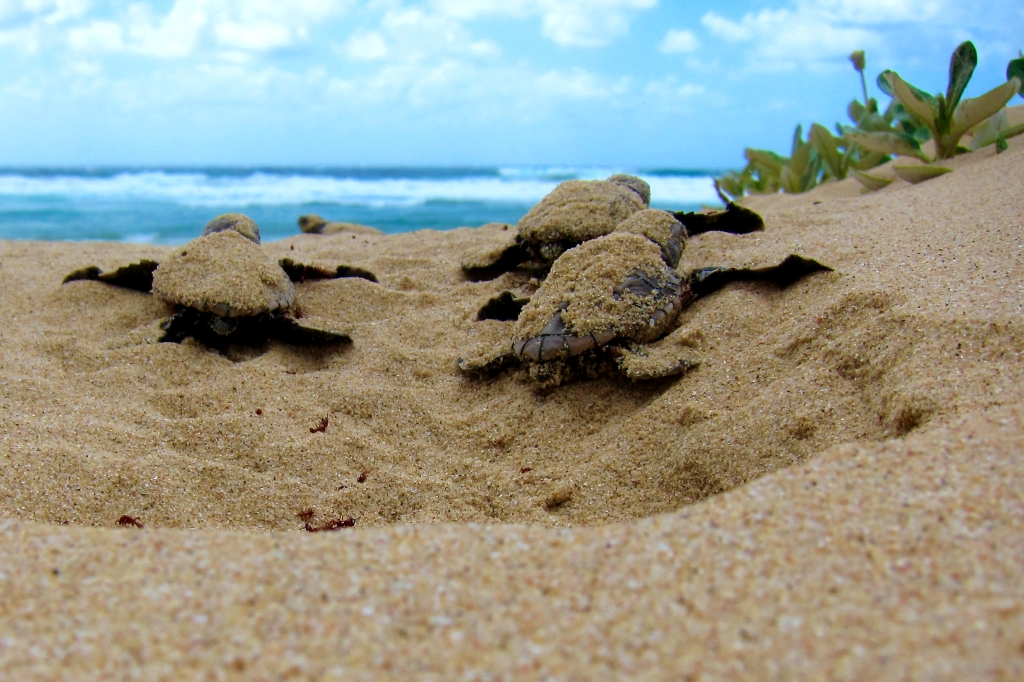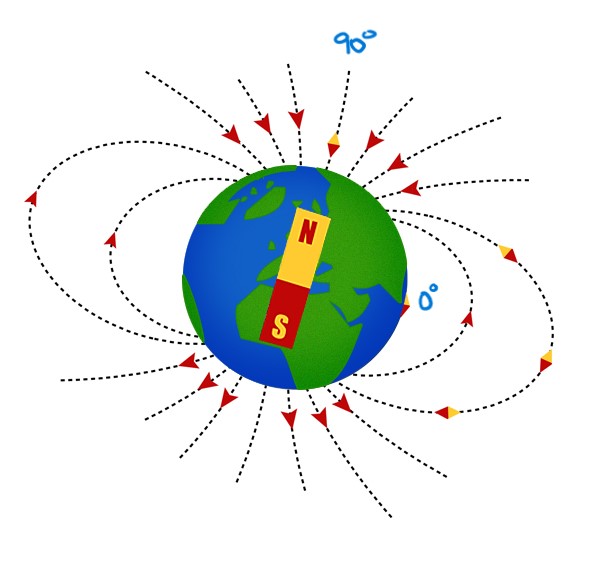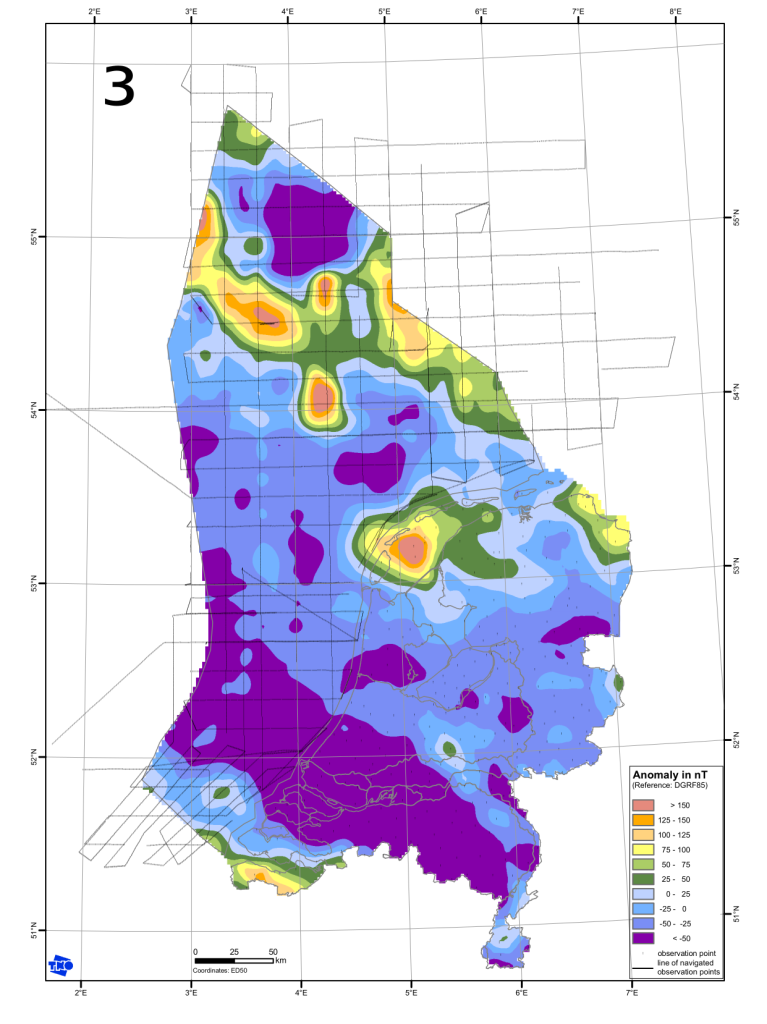Imagine if people had their own built-in compasses – this would be hugely helpful to us in navigating around in Earth’s magnetic field. Unfortunately, humans can’t innately sense Earth’s field, but a particular type of bacterium can and puts its internal compass to good use in orienting itself in its environment. This magneto-sensing trait is made possible by a chain of magnetite (Fe3O4) inside the bacterium, as seen here by electron microscope; the chain acts as a long magnet which will physically turn the little organism so that it aligns with Earth’s field.

These bacteria live in mud at the bottom of swamps and, if the mud is disturbed so that the bacteria are stirred out of it, it’s super helpful for them to be able to orient themselves with Earth’s field to swim down into the mud again.
Although the mechanisms are still not clearly understood, there is evidence that more complex organisms also sense Earth’s magnetic field and use it as a means of navigation. Experiments with sea turtle hatchlings have demonstrated that their direction of migration is influenced by the external magnetic field in their environment. Scientists are also studying butterflies, beluga whales, homing pigeons, and foraging honeybees to better understand the role that Earth’s magnetic field might play in their interactions with the environment.

To make up for our inability to feel Earth’s field, humans started using tools to navigate magnetically by the 12th century, even if we didn’t understand the underlying physics at the time. A few hundred years later, William Gilbert realized that the magnetite in a ship’s compass needle aligns with Earth’s field and points towards the North Pole because of magnetic attraction, which every good Girl Guide/Boy Scout can now tell you. With further investigation, in addition to all pointing towards the north, the magnetic field lines around Earth were found to make a very distinctive pattern as sketched here. In particular, the angle between the field lines and the horizon (the “dip” angle) changes significantly from the Equator to the poles – at the Equator, the field lines are parallel to Earth’s surface (0°) and arc inwards as we move towards the poles. By the time we are at the top or bottom of the globe, the field lines cross the surface at right angles (90°). So, if we can measure the dip angle at our location, we have a way of figuring out our latitude. Two measurements of the field can tell us which way is north and how far we are from the top or bottom of our lovely blue and green sphere.

Turns out that loggerhead turtles can do all that and more without fancy gadgets or tools. Experiments beginning in the 1990s show that these adorable reptiles can sense the direction of the magnetic field in the plane of Earth’s surface (like a compass), the strength of the field at their location and the dip angle, so they can figure out where they are while following their circular loop around the Atlantic. Immediately after hatching in southern Florida, the turtles head out into the ocean to loop around the Sargasso Sea enroute to the sunny coasts of Spain & Portugal, then head down to Northern Africa before swirling back around to Florida some 5 to 10 years later to prepare for breeding the next generation of turtles. A true circle of life! On such an epic journey, turtles need to stay on track to remain in waters of appropriate temperature and salinity, as well as making sure they have access to the relevant food sources. Just about every ocean on Earth has its own identifying magnetic features in terms of intensity and dip angle patterns (as shown here for the North Sea), which provides our epic swimmers with the “road” map for their adventures. These unique magnetic features are also likely the means by which the adult turtles are able to return, with startling precision some ~20 years later, to the breeding beaches where they hatched, having imprinted to the specific intensity and dip angle signature when they first fled for open waters all those years ago.

Earth’s magnetic field is ideal for turtles to rely on – it’s always there, never covered over by clouds, and you don’t have to worry about the signal getting through to the depths of the sea as you do with sunlight or starlight. In hindsight it seems to make so much sense, but incredibly this was just a fringe hypothesis less than a generation ago. And it’s not just for turtles, magnetic field mapping is now known to play a role in the daily lives of animals ranging from lobsters to birds – keeping them in the ideal ecosystem for survival, following migration paths, finding their way back to breeding grounds, etc. Magnetic field sensing appears likely to explain many of the most impressive navigational feats in the (non-human) animal kingdom. The reliability of magnetic-field navigation is also why it was so crucial for humans sailing around the globe for centuries, but we had to develop measurement devices to help us in sensing these fields instead of relying on our own biology to do it for us.
Image Citations
Opening image of a swimming loggerhead turtle: “Loggerhead Sea Turtle” by Mike Gonzalez (TheCoffee) is licensed under CC BY-SA 3.0
Magnetotactic bacterium: https://commons.wikimedia.org/wiki/File:Small_magnetosome.jpg
Hatchling loggerhead turtles on the beach: “Loggerhead turtles – Mabibi” by Jeroen Looyé is licensed under CC BY-SA 2.0
Sketch of Earth’s magnetic field: “Earth’s magnetic field” by Zappy’s is licensed under CC BY 2.0
Magnetic map of the North Sea: “File:North sea Anomaly of the Earth’s magnetic field strength (TNO-NLOG).png” by Tijmen Stam / IIVQ – conversion from NLOG’s PDF (see source) is licensed under CC BY 3.0.
References
The Spinning Magnet: The electromagnetic force that created the modern world and could destroy it – Alanna Mitchell 2018, Penguin Random House
Furry Logic by Matin Durrani and Liz Kalaugher, Bloomsbury Press 2016
Magnetic maps in animal navigation KJ Lohmann, KM Goforth, AG Mackiewicz, DS Lim, and CMF Lohmann Journal of Comparative Physiology A (2022) 208:41–67 https://doi.org/10.1007/s00359-021-01529-8
